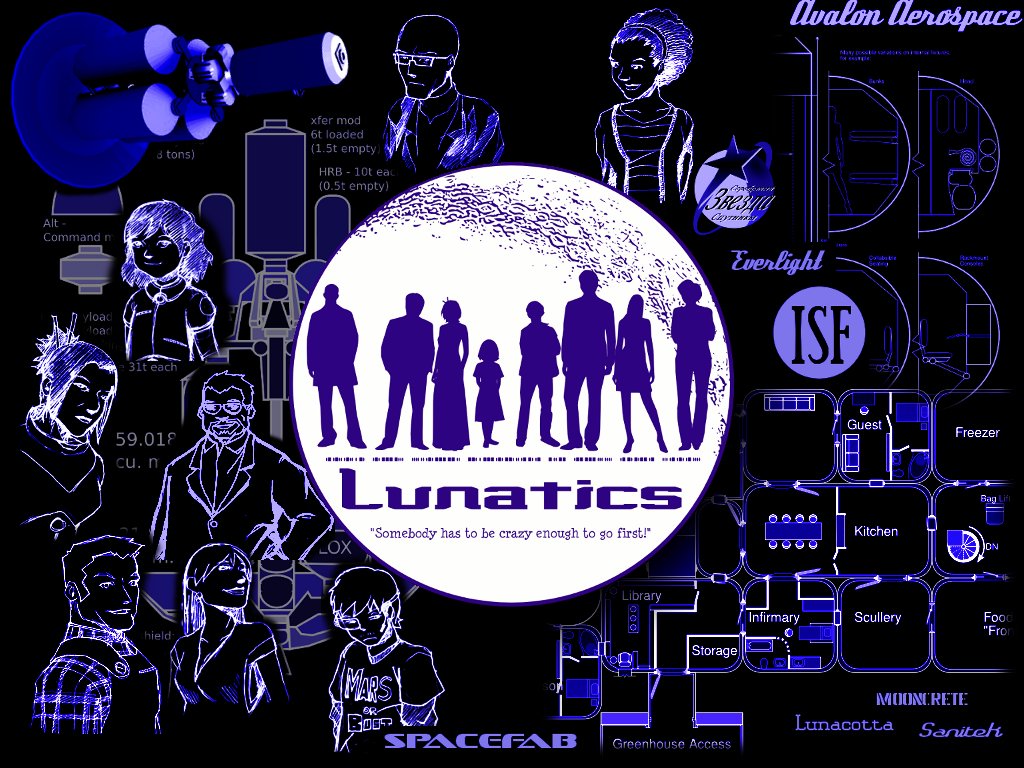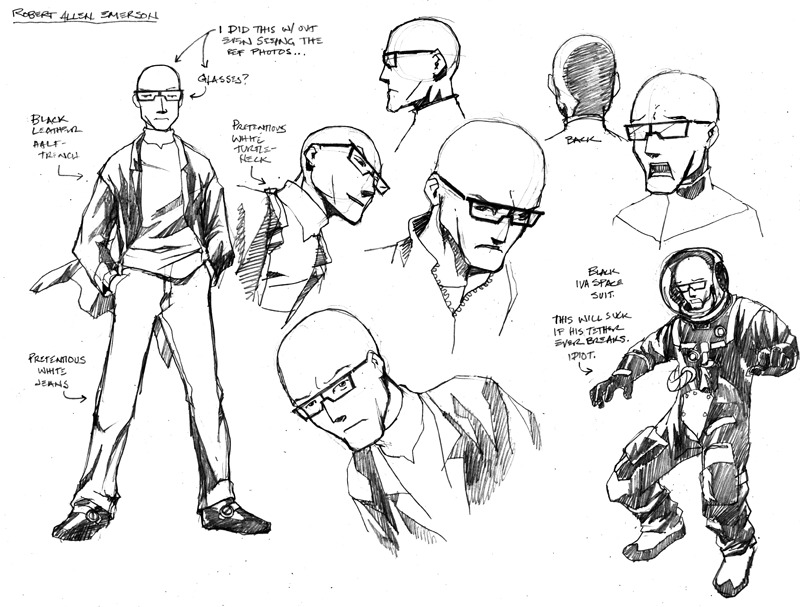We're putting the finishing touches on our initial Kickstarter campaign for our free-culture science-fiction web series "Lunatics", which is being made with free software tools in a process very similar to free software development. This is an experiment in commercial free culture, using the platform that has quickly come to be the standard for this kind of project fund-raising. Is Kickstarter all it's cracked up to be? I think it is, and for this installment in my "making free movies with free software" series, I'd like to explain why.
Making Movies with Free Software
This article is part of an on-going series on "Making Free Movies with Free Software".
First of all, let me make a shameless plug for my project: "Promote space development, support free culture, get cool stuff -- pledge in the "Lunatics" pre-production Kickstarter campaign!" Seriously. Lunatics is going to be awesome, and I think we're going to have great results even with just the pre-production materials.
About Kickstarter
Kickstarter lies between a conventional "fund raising" system (like you would see for charities, your local youth group, or public television) and a pre-sale system, which is closer to how the Blender Open Movies were marketed. The rewards in the Kickstarter can range from simple token gifts to say "thank you for supporting us" to simple commodity items sold in advance so as to remove the risk from production fixed costs.

Indeed, intellectual production (writing, coding, filming, etc) can be regarded simply as a fixed cost of producing a commodity item (like a DVD movie disk). Or it can be regarded as a public good produced through a system of collective patronage. There isn't really a sharp difference between these two interpretations -- because they really are just that: interpretations. If one of the two makes you feel better, then pick that one. Because the reality is that both are equally sensible ways of thinking about what we are doing.
The best rewards in a Kickstarter campaign are the ones that don't cost much materially, but provide a connection to the artists behind the production. One of the most popular items is signed memorabilia.
Character Design for 'Lunatics'
Our first Kickstarter is prompted by the fact that I needed (or very much wanted) to commission a good character design artist for "Lunatics". After much consideration, I asked Daniel Fu (Author of web comic The Retriever) to do the job. We started with a small commission for concept art, which I paid for out of pocket. This Kickstart's main goal is to pay for the much larger task of detailed design for each of the characters (currently, we plan to do 16 characters -- the 8 main characters, 4 secondary characters, and 4 generic "extras" designs that we can remix and stretch to make background characters in the story. We need $1600 to pay this commmission (basically, $100 per character).

Other Pre-Production Work
During this time, Rosalyn will be finishing the script and I will be creating lots of plan drawings and layouts, and making a lot of 3D models in Blender. In particular, I need models of the "ISF-1" colony and the "Lunar Transportation System" and the "Gagarin's Start" launch complex in Baikonur for the pilot episode. In fact, I had decided that I needed at least simple versions of these to make good storyboard images, because I was having some issues with consistency between my different hand-drawn sketches (for example, I kept changing the design of the Lunar Transportation System "Moon Shuttle" in incompatible ways, so that the storyboard drawings were becoming incomprehensble).
I've also worked extensively on the sound. I never really thought of myself as a "sound person", but it seems I do have a bit of a knack for it. With all of that, I will have everything needed to create a full-length "story-reel" animatic (meaning an animatic consisting of storyboards cut to the soundtrack) of the pilot episode of Lunatics, "No Children in Space". There will probably even be a few moving 3D model shots.
I'm hoping that people will see this as a lot of progress for the $2400 goal that I'm setting on this Kickstarter.
Cleaning all of this up to create consistent models, drawings, story-reel, and animatic is a big project. I wasn't thinking about that a lot as an expense, because I expected to do it myself, but it clearly is a lot of work, and it will produce a lot of results. And ultimate results -- in the form of "rewards" is what you are selling in a Kickstarter campaign.
Converting Intellectual Products into Material Rewards
At first, I thought this would be hard -- "How are we going to find enough 'unique stuff' to sell when we are basically an online collaborative project?"
In fact, though, it hasn't really been all that hard. The obvious no-brainer was to include the original drawing sheets that Daniel creates as high-end items. The concept sheets are priced at $250 and the model/design sheets at $300.

Along with the model sheets, there will also be a "character line-up sheet" (this is a group drawing of the characters -- its main purpose is to establish the correct scale relationships between characters. I don't intend to sell this one -- at least not yet -- but it will be the guide for new marketing artwork we created for Lunatics. We've been using the "silhouettes" logo for some time now, but after this project we'll be able to "fill in" the characters with full drawings (we'll also create an updated "silhouettes" drawing that matches them).
With that, of course, we can make posters. The whole collection of art can be put on DVD or on a custom USB drive. And most of it can be included in a nice collector's volume book.
There's also the motivation of being listed as a supporter -- anyone paying $1 or more will be listed as a "Backer" in a "Thank You" notice on the disk we're producing. And anyone (or up to eight anyones, anyway) can sponsor us for $400 and get their company logo on the books, poster, and disk cover art that we produce.
It's all about "selling containers" (as Nina Paley calls it). It's also about creating a nice ladder of increasingly valuable items so that people have a "reason to buy" at the level they're comfortable with.
In fact, Kickstarter is really just a practical implementation of Mike Masnick's "Connect with Fans + Reason to Buy" business model concept.
Costs
Of course, "There Ain't No Such Thing As A Free Lunch" (TANSTAAFL), so it's worth noting that Kickstarter will cost us some money. Kickstarter charges a pure percentage, though, which distinguishes it from some other services. Thus there is no financial penalty for a failed Kickstart, which is a very useful thing for anyone (like me) who probably can't afford that financial risk.
On the other hand, the amount they take is also proportional to how much you raise -- this can be quite a lot of money on a large fund-raiser. Probably the most famous and possibly the largest Kickstarter campaign was that of Diaspora, in which they raised about $200,000 -- this means they paid about $16,000 in fees to Kickstarter and Amazon! That's a lot of money for hosting a fund-raiser.
But there's another side to that: Kickstarter is incentivized to help you maximize your fund-raising. They pick projects, help you set yours up, and they provide a lot of well-maintained and well-documented features to make this work. So in fact, I think this is a good thing.
Overheads and Risks
The other major cost of course, is the manufacturing, handling, and shipping costs associated with the "rewards".
This is probably my biggest complaint about Kickstarter's design: the target goal is based on your top line (i.e. "revenue") and not on your bottom line (i.e. "profit"). This can make pricing a little tricky.
I had to forego including a commodity-priced unsigned version of the "Pre-Production Art Book" (at, say, $25 each) because the margin would be too thin -- if I were unlucky enough to reach my goal of $2400 entirely with the commodity book sales, then I would not make the $1600 in profit needed to pay the commission and get the work done. That's a very bad situation -- I would be in default.
In order to avoid that, I would have to raise the minimum goal up by three or four times (to about $6400). But of course, it's much more likely that I would get a mixture of sales on different items, so I'd probably wind up with a much higher amount of money than I need.
That would be fine if it happened, but there's also the possibility that I would have raised plenty of money to deliver on my promises, but still have the Kickstart fail because I hadn't reached my goal.
The revenue-based goal is attractive in its simplicity, but it creates this risk. If the Kickstart's success were based on profit instead of revenue, I wouldn't have to worry about this so much. As it is, I had to set a price-to-cost ratio, which I decided should be about 4:1 (i.e. my most expensive reward costs me about 1/4 the reward price in materials, handling, and shipping costs). I'm ignoring my own labor here, because I'm willing to risk that.
Signing stuff is a great way to add value without adding cost. So, in fact, all of the books in the Kickstarter sale will be signed by me, and they'll cost $50 because of that. Other things are not so hard -- people won't really complain about $19 for a disk full of data, while the disk itself costs less than a dollar. If I get a very small number of these, I can just burn DVD-Rs on my own computer. If I get lots, I can send the data to a disk duplicating company, and the bulk discount will bring my costs down to a reasonable point.
There's more about all of this manufacturing and retail business, but you'd probably find it tedious. Suffice it to say: you will have to think about such stuff if you do a Kickstart to fund your own project.
Good Odds
It is an unfortunate truth that money and I do not along well. I've succeeded at lots of other things, but I'm too honest to be a good salesman. I can't sell a product I don't believe in, and I can't make myself believe in a product just so I can sell it. Indeed, I'm not sure that I can ever remember a fund-raiser that was truly successful. Certainly one of my first obstacles on this project was my lack of confidence (and a lot of disturbing and shaming flashbacks to childhood school fundraisers).
So, I have to say that the fact that Kickstarter reports a success rate of 40% (for accepted projects) is pretty reassuring. That's a pretty astoundingly high success rate -- it almost makes me think that even I can do this.
And as I go through the process, I think I can believe it. Kickstarter is doing a lot of things right -- they have taken an excellent model for collective patronage and/or pre-sales and they've smoothed out most of the bumps that get in the way of inexperienced marketing people like me.
The attraction here is that I finally can make the thing I do care about central to raising the money. So I'm putting my all into it. I truly hope there's enough people out there interested in this concept to make it go, because I really want to make "Lunatics" happen.
Licensing Notice
This work may be distributed under the terms of the Creative Commons Attribution-ShareAlike License, version 3.0, with attribution to "Terry Hancock, first published in Free Software Magazine". Illustrations and modifications to illustrations are under the same license and attribution, except as noted in their captions (all images in this article are CC By-SA 3.0 compatible).